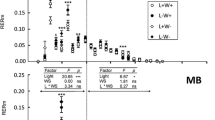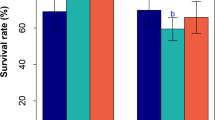Abstract
Shoot morphology at the emergence ofDioscorea japonica Thumb. could be classed into the following three types: (1) a seedling emergence with only one leaf (Se type), (2) a plant consisting of one stem and one leaf, which has emerged from a small tuber (rhizophore) or bulbil less than 50 mg in dry weight (S type) and (3) a twiner with many leaves, which has emerged from a tuber or a bulbil of more than 50 mg in dry weight (L type). The Se type failed to develop beyond the second leaf stage in 1.5% sunlight exposure.
The effects of initial plant (seeds, bulbils and tubers) size and light intensity on plant growth were analyzed. The larger the initial plant size was, the greater the growth in height and leaf area was. The distribution ratio of assimilated substances in leaves was high in smaller plants at the early growth stage. The distribution ratio in the tubers of larger plants became high at the early stage of growth. In all three types at over 3% sunlight exposure, the switch-over from the vegetative to reproductive growth phase occurred simultaneously at a later growth stage, but the Se type at 1.5% sunlight exposure showed a very early switch-over in its development; this switch-over may be related to shade tolerance capacity. The L type showed shade avoidance by forming a large productive structure as a twiner
Similar content being viewed by others
References
Baskin, J.M. andC.M. Baskin. 1979. Studies on the autoecology and population biology of the weedy monocarpic perennials,Pastinaca sativa. J. Ecol.67: 601–610.
Bierzychudek, P. 1980. Life histories and demography of shade-tolerant temperate forest herbs: a review. New Phytol.90: 757–776.
Blackman, G.E. andA.J. Wilson. 1951. Physiological and ecological studies in the analysis of plant environment: VII. An analysis of the differential effects of light intensity on the net assimilation rate, leaf-area ratio and relative growth rate of different species. Ann. Bot.15: 373–408.
— andJ.N. Black. 1959. Physiological and ecological studies in the analysis of plant environment: XI. A further assessment of the influence of shading on the growth of different species in the vegetative phase. Ann. Bot.23: 51–63.
Grime, J.P. 1977. Evidence for the existence of three primary strategies in plants and its relevance to ecological and evolutionary theory. Amer. Nat.111: 1169–1194.
Hiroi, T. andM. Monsi. 1964. Physiological and ecological analyses of shade tolerance of plants. 4. Effect of shading on distribution of photosyntheate inHelianthus annuus. Bot. Mag. Tokyo77: 1–19.
Hirose, T. andN. Kachi. 1982. Critical plant size for flowering in biennials with special reference to their distribution in a sand dune system. Oecologia55: 281–284.
Hoefs, M.E.G. andJ.M. Shay. 1981. The effects of shade on shoot growth ofVaccinium angustifolium Ait. after fire pruning in southeastern Manitoba. Can. J. Bot.59: 166–174.
Hogetsu, K., Y. Oshima, B. Midorikawa, Y. Tezuka, M. Sakamoto, I. Mototani andM. Kimura. 1960. Growth analytical studies on the artificial communities ofHelianthus tuberosus with different densities. Jap. J. Bot.17: 278–305.
Kawano, S., J. Masuda andH. Takasu. 1982. The productive and reproductive biology of flowering plants. IX. Further studies on the assimilation behaviour of temperate woodland herbs. J. Coll. Lib. Arts, Toyama Univ. Nat. Sci.15: 101–160.
Kondo, Y. andY. Oshima. 1981. Propagule size and growth of plant—phenomenon of gaining in growth by plants handicapped by small initial size. Jap. J. Ecol.31: 217–219.
Lee, S.M. andP.B. Cavers. 1981. The effects of shade on growth, development and resource allocation patterns of three species of foxtail (Setaria). Can. J. Bot.59: 1776–1786.
Loach, K. 1970. Shade tolerance in trees seedlings: II. Growth analysis of plants raised under artificial shade. New Phytol.69: 273–286.
Midorikawa, B. 1959. Growth-analytical study of altherbosa on Mt. Hakkoda Northeast Japan. Ecol. Rev.15: 83–117.
Mutoh, N., K.H. Yoshida, Y. Yokoi, M. Kimura andK. Hogetsu. 1968. Studies and the production processes and net production ofMiscanthus sacchariflorus communities. Jap. J. Bot.20: 67–92.
Nomoto, N., H. Iwaki andM. Monsi. 1961. Physiological and ecological analyses of shade tolerance of plants. 1. Growth of green-grams under varying light intensities. Bot. Mag. Tokyo:74: 386–394.
Ogura, Y. 1938. Problems in morphology (13). Bot. and Zool.6: 139–148 (in Japanese).
Ohwi, J. 1975. Flora of Japan. Shibundo, Tokyo (in Japanese).
Onwueme, I.C. 1978. The Tropical Tuber Crops. John Wiley and Sons, Chichester.
Packham, J.R. andA.J. Willis. 1977. The effect of shading onOxalis acetosella. J. Ecol.65: 619–642.
Rabinowitz, D. 1978. Mortality and initial propagule size in mangrove seedlings in Panama. J. Ecol.66: 45–51.
Stebbins, G.L. 1976. Seed and seedling ecology in annual legumes. 1. A comparison of seed size and seedling development in some annual species. Ecol. Plant.11: 321–331.
van der Meijden, E. andR.E. van der Walls-Kooi. 1979. The population ecology ofSenecio jacobaea in a sand dune system. I. Reproductive srategy and the biennial habit. J. Ecol.67: 131–153.
Werner, P.A. 1975. Predictions of fate from rosette size in teasel (Dipsacus fullonum L.). Oecologia20: 197–201.
Yokoi, Y. 1976. Growth and reproduction in higher plants. I. Theoretical analysis by mathematical models. Bot. Mag. Tokyo89: 1–14.
Author information
Authors and Affiliations
Rights and permissions
About this article
Cite this article
Hori, Y., Oshima, Y. Life history and population dynamics of the Japanese Yam,Dioscorea japonica thunb.. Bot Mag Tokyo 99, 407–418 (1986). https://doi.org/10.1007/BF02488719
Revised:
Accepted:
Issue Date:
DOI: https://doi.org/10.1007/BF02488719




